Discovering British Railway Insulators
by Stewart Firth
Reprinted from "Crown Jewels of the Wire", February 1991, page 7
About the Author
Every English schoolboy in the 1950's went through the train-spotting phase
and I was no exception. Steam engines reigned supreme and nobody suspected that
it would end. Then I grew up, went to University to study Electrical
Engineering, married and raised a family.
Once these chores were over with, I
was able to actively pursue my interest in railways once again. But what a
change had taken place -- steam had been replaced by diesel and electric
locomotives, semaphore signals had given way to colour lights, and most minor
railway lines and small stations had long since closed down.
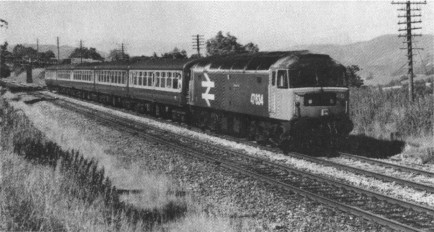
A typical scene on the Settle-Carlisle Line in 1990. A class 47 diesel
locomotive hauls the afternoon Carlisle to Leeds train on the
14th of July. The
telegraph poles are still standing,
but unused with red-glazed "pots"
on the top arms.
Undeterred, I was not going to let nostalgia be a thing of the past. There
had to be something I could dig up which would rekindle the memories of those
halcyon days of my youth. So I settled for steam railway photography (there
still is the occasional steam special, locally), collecting cast iron Victorian
railway signs (trespass notices etc.) and railway telegraph insulators.
|
(Right) Close-up of the insulator group on previous photograph. Mostly LMS
cordeaux 1930/1948 types with one corrugated insulator (Far left, fifth crossarm
down). A red-glazed cordeaux sits on each end of the top crossarm. |
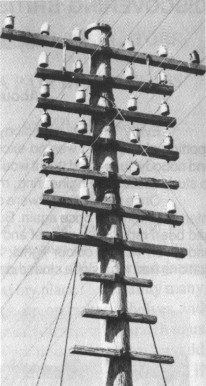 |
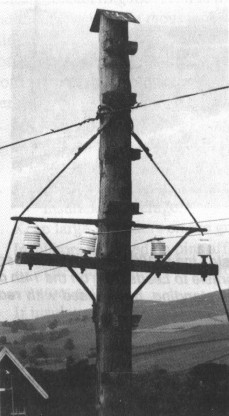 |
(Left) A
rare sight in 1990 -- three Fuller/Langdon patent corrugated insulators
stand sentinel over Norton-in-Ribblesdale station on the Settle-Carlisle line. |
Since my house is now groaning under the weight of too much cast iron, I have
to concentrate on insulators -- they don't take up quite as much space.
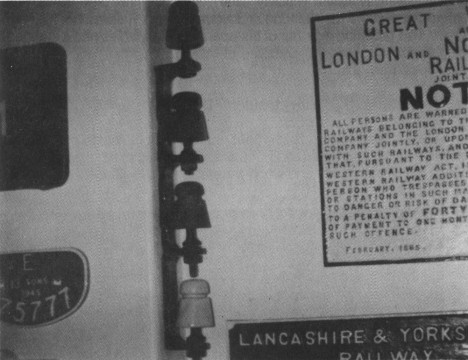
Varley's Z-type patent insulators on original bracket for mounting under
a
railway bridge, recovered from a disused section of the North
Eastern Railway in
County Durham. (From top to bottom) Brown
stoneware marked TMC; Dark
brown-glazed porcelain, Black composition;
White porcelain. Note: Some of my
cast iron sign collection.
A History Lesson
Let's just turn the clock back a hundred years. Victorian England was criss-crossed
by a veritable maze of railways, operated by over a hundred different railway
companies. There were more than 25 railway companies operating in my home county
of Yorkshire.
After the First World War was over, economic depression set in and
the railways had to be made more efficient if they were to survive. On the 1st
of January 1923, all the smaller companies were, by Act of Parliament, swallowed
up by the major companies.
The "Midland Railway Co." based in Derby,
the "Lancashire and Yorkshire Railway Co." based in Manchester
amalgamated with the London-based "London and North Western Railway
Co." and some Scottish lines to be henceforth known as the "London Midland and Scottish
Railway Co.".
Similarly, the "North Eastern Railway" based in
York joined forces with the "Great Northern Railway", the "Great
Central" and the "Great Eastern" to become the "London and
North Eastern Railway Co."
This grouping together of the operating
companies had a standardising effect on the design practices of railway
equipment and telegraph insulators in particular.
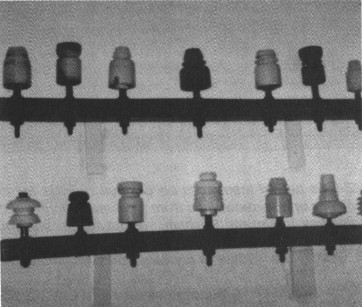
Part of the author's collection. (Top row, left to right:) Very early
Lancashire & Yorkshire Rly (c. 1880); Pot head terminator, LNER, 1940;
Standard cordeaux, GPO, 1950; Red-glazed terminator, LMS, 1935; Lancashire &
Yorkshire Rly, 1904; Black composition terminator, GPO type; Miniature cordeaux.
(Bottom row, left to right) Shackle insulator, c. 1900; Varley's Z-type in brown
earthenware, C. 1890; Pot head terminator, LMS, 1938; Corrugated insulator, MR,
1886; Double-grooved cordeaux, LMS, 1946; early Langdon "cone"
insulator, c. 1890.
Early Insulator Design
In the early days (1850-1900), there was a multitude of patented designs
mainly manufactured from stoneware and glazed brown, though ebonite, black
composite and wood were also used. Glass was virtually never used in England for insulators. Most of these very early designs had no
inner shed (North American collectors refer to this as an inner skirt) and are
now virtually unobtainable in-situ. The many Varley patents date from this
period.
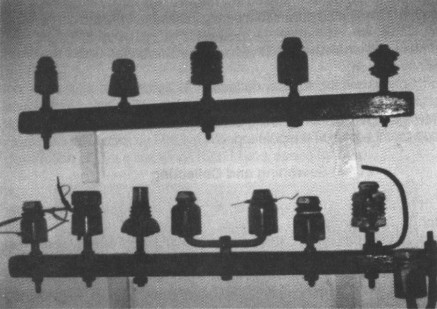
Early brown earthenware insulators. (Top row, left to right) Double-grooved
GPO cordeaux, Varley's Z-type from HER line; Corrugated insulator, Midland Rly;
Cordeaux, marked "Bullers Ltd London", Midland Rly; Spool insulator,
LNER line. White porcelain insulators smoke-stained as found. (Bottom row, left
to right) Double-grooved cordeaux, LNWR; large terminator, LNER; Langdon triple
shed, Midland Rly; Standard cordeaux, LMS; Standard cordeaux, LNER; Lancashire
& Yorkshire Rly, LYR 13; Corrugated insulator, Midland Rly, with lightning
rod; LMS pot head terminator on J-bolt.
During the period c. 1880-1920, white porcelain became the predominant
material. The design became more complex (often for no real reason other than
trial and error) with multiple sheds and multiple side grooves. Langdon cones,
inverted cones and corrugated insulators date from this period.
From the 1920's
onwards, variants of the basic Cordeaux design became predominant with pot head
(dry spot) terminal insulators used for terminating a line at a signal box or
tunnel entrance. These were mostly off-white or cream colored porcelain, though
brown glazed porcelain and black composition was also occasionally used. Sometimes a red glaze was added
during the manufacturing process. I have only ever observed these red insulators
on the outermost top crossarms of telegraph poles and were presumably for
carrying higher voltage power supply circuits.
English telegraph practice has
always been to put multiple oak or teak crossarms on pitch pine poles and the
railways were no exception. Very early spindles (pins) were cemented into the
insulator but by about 1880 this practice had mostly died out as screwed
spindles became the norm. Most spindles were straight, but "J"-shaped
and "W"- shaped spindles were sometimes used when the insulator had to
be positioned under the cross arm for any reason.
Special means for the
deflection of lightning strikes does not appear to have been a high priority
here in England. However, I have found just a few examples of iron lightning
detector rods which were arched over the insulator mounted on the pole top.
Searching and Collecting
I have never purchased an insulator in my collection from another collector.
These sources don't really exist in the UK yet. The enjoyment has always been in
searching, collecting and preserving in the true W. Keith Neal style.
Some were
found buried in topsoil or undergrowth near the spot where poles have been
removed. Others have been retrieved, still attached to the cross-arms, having
been left on embankments by railway workers who didn't take them back to the
depot for scrap (thank goodness).
Another useful source has been old station
buildings and disused engine sheds, though permission from current owner has to
be obtained, they usually agree but I believe they think I'm just a little bit
mad.
When it is suspected that existing lines are to go underground and that
poles are to be taken down, we request the local Railway Signal and Telegraph
Staff to save whatever they can. They are usually co-operative. The fact that my
son, Russell, works for British Rail Signal and Telegraph Department in York
makes life easier. The intelligent gathering and the obtaining of official
Railway permission are an essential part of our collecting process.
Once the
insulators have been recovered and brought home, the work of restoration and
display can begin. Dirt and surface grime can normally be removed by washing.
Heavily smoke-stained items can be brought back to pristine condition by soaking
in dilute hydrochloric acid. I occasionally leave on the black soot deposits and
just buff up the surface which can be very attractive. This leaves something of
a reminder of the countless steam engines that must have passed by.
Insulator Markings
Most insulators possess a manufacturer's trademark which may include the date
and pattern number. More rarely, the original railway companies' initials were
stamped or glazed on with or without a date. For example:
LYR 07 = Lancashire n Yorkshire Rly Co. 1907.
LMS 29 = London Midland and
Scottish Rly Co. 1929
These are the more highly prized.
Initials and trademarks from the various manufacturing companies have been
found including:- Fuller and Langdon, Bullers, Jobson Brothers, T and T, G and
G, and TMC. Please refer to that excellent book, Worldwide Porcelain Insulators
by Marilyn Albers and Jack Tod, for a more complete description of these
markings than I have space for here.
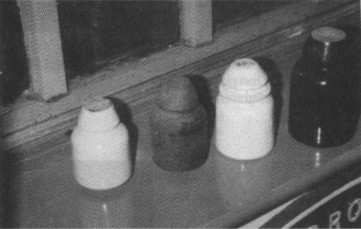
A selection of Cordeaux types including a red-glazed LMS (right).
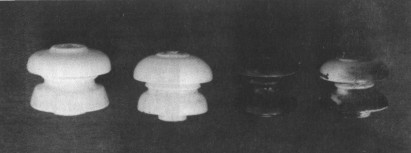
Variations of Bright's patent insulators, originally used
to lead down a
telegraph line to trackside huts.
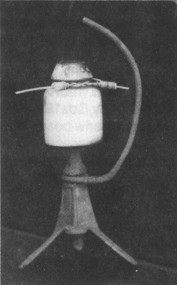
An LNER Cordeaux (U-1451) with original copper binding, on pole-top mounting
bracket with lightning de flector. |
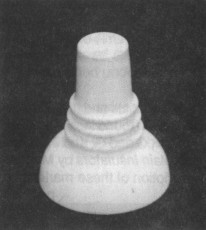
An early Langdon patent cone insulator, U-1 981. |
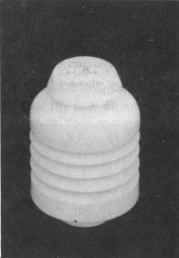
Corrugated insulator (U-1 987) marked
"Fuller Landon Patent 86" (i.e. 1886) |
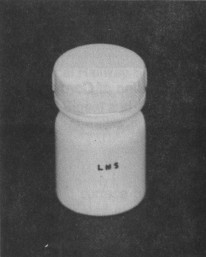
LMS pot head (dry spot) U-1 938A, terminal insulator, c. 1930 |
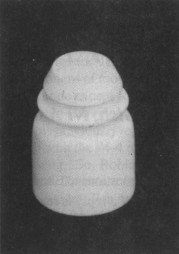
LYR (U-1 563) style marked LYRO4 (1904) |
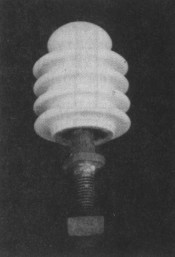
Bennetts patent insulator (U-2839) on original spindle (1939) recovered from
disused Engine Shed in the Hull Area. |
Many of our insulators are still coated with the original smoke which further
enhances their value to us.
Whilst building up a modest collection, we have
obtained a few spare and surplus examples. If anyone is interested in having
these, we are prepared to ship them out, complete with a full written
description and history of each individual insulator. (see advertisement on
pages 46-47).
Meanwhile, we shall continue to try and break new ground here in
England (in more ways than one!) We hope to dig up many a treasure yet buried
and maybe start a trend here which has progressed so far in the U.S.A.
References:
Searching for Railway Telegraph Insulators, by W. Keith Neal -
1982 - Signal Box Press
Worldwide Porcelain Insulators, by Marilyn Albers and
Jack H. Tod - 1982/1988
| 